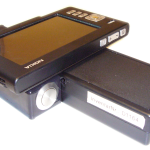
As home appliance networks with numerous, heterogeneous home appliances are becoming more and more popular and affordable, the demand for new concepts of user interfaces arises. These complex networks facilitate unlimited multilayered applications and services and enable previously “stupid” devices to be operated in an integrated and intelligent way. For an appliance in a smart home environment it therefore is no longer sufficient to provide an interface for its standalone use. It has to provide a UI for integrated device operation and device programming. So to speak, user interfaces are growing with increased capabilities and interdependencies of the devices they control.
From a user perspective, growth of interfaces is opposed by the demand for comfortable, intuitive operation of appliances, so despite increasing capabilities of devices and rising complexity we want to have intuitive and ergonomic UIs.
This idea has led to the development of a universal haptic remote control for smart home environments, combining gesture recognition with graphical user interfaces. This hybrid approach was chosen because a GUI is the most efficient way to handle the multiple variables of a smart environment whereas motion detection has proven most convenient for simple commands.
To operate or program a formerly “stupid” appliance – a radiator for example – according to the capabilities of the home network, the Smart GUI Controller is pointed at the appliance. After tilting the SGUIC backwards, a graphical interface of the appliance is displayed on the SGUIC. Any variable, service or interdependency of the appliance may now be controlled on the SGUIC device. The GUI may also through a tilt forward in the direction of any GUI rendering device, be displayed on any other screen. In the latter case the interface may be controlled via SGUIC or through the target screen device.
The Smart GUI Controller provides developers of physical smart appliances with an option to create low cost “virtual” interfaces, which are scalable and very flexible since they are based on software only. These “virtual” GUIs are then stored with the representation of appliances in the home network. In the SGUIC, an accelerometer and a compass module identify user gestures and submit a GUI request to the home server via WLAN. The home network in turn responds with the submission of an accurate GUI.
The use of virtual interfaces provides a high degree of interface personalisation. In fact there may be as many “virtual” UIs for each appliance stored on the home server as there are possible users. The rendering may vary for various reasons such as user authorisation or user habits and preferences. It may vary for practical or esthetical reasons and may be scaled from maximum number of controllable parameters to maximum simplicity of appliance operation.
